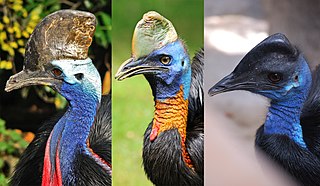
Cassowaries are flightless birds of the genus Casuarius in the order Casuariiformes. They are classified as ratites: flightless birds without a keel on their sternum bones. Cassowaries are native to the tropical forests of New Guinea, the Aru Islands (Maluku), and northeastern Australia.

A ratite is any of a group of mostly flightless birds within the infraclass Palaeognathae. They are mostly large, long-necked, and long-legged, the exception being the kiwi, which is also the only nocturnal extant ratite.

The bird family Casuariidae has four surviving members: the three species of cassowary and the emu.
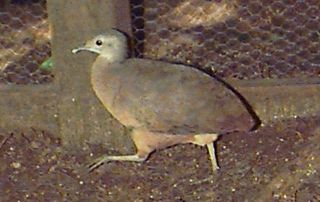
The little tinamou is a species of tinamou. It is found in Central and South America, as well as on the Caribbean island of Trinidad.

The southern cassowary, also known as double-wattled cassowary, Australian cassowary, or two-wattled cassowary, is a large flightless black bird, found in Indonesia, Papua New Guinea, and northeastern Australia. It is one of the three living species of cassowary, alongside the dwarf cassowary and the northern cassowary. It is a ratite and therefore related to the emu, ostriches, rheas and kiwi.
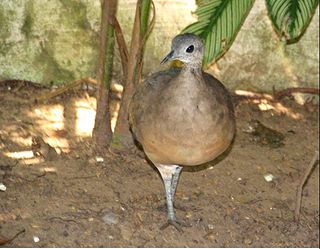
The white-throated tinamou is a species of bird native to the Amazon rainforest of Brazil, northern Bolivia, southeastern Colombia, northeastern Ecuador, eastern Peru and southern Venezuela.

The brown tinamou is a brownish ground bird found in humid lowland and montane forest in tropical and subtropical South America.

The great spotted kiwi, great grey kiwi or roroa is a species of kiwi endemic to the South Island of New Zealand. The great spotted kiwi, as a member of the ratites, is flightless. It is the largest of the kiwi. The rugged topography and harsh climate of the high altitude alpine part of its habitat render it inhospitable to a number of introduced mammalian predators, which include dogs, ferrets, cats, and stoats. Because of this, populations of this species have been less seriously affected by the predations of these invasive species compared to other kiwi. Nonetheless, there has been a 43% decline in population in the past 45 years, due to these predators and habitat destruction. This has led it to be classified as vulnerable. There are less than 16,000 great spotted kiwis in total, almost all in the more mountainous parts of northwest Nelson, the northwest coast, and the Southern Alps. A minority live on island reserves.

The Casuariiformes is an order of large flightless birds that has four surviving members: the three species of cassowary, and the only remaining species of emu. They are divided into either a single family, Casuariidae, or more typically two, with the emu splitting off into its own family, Dromaiidae.

The dwarf cassowary, also known as Bennett's cassowary, little cassowary, mountain cassowary or muruk, is the smallest of the three extant species of cassowaries.

Palaeognathae is an infraclass of birds, called paleognaths or palaeognaths, within the class Aves of the clade Archosauria. It is one of the two extant infraclasses of birds, the other being Neognathae, both of which form Neornithes. Palaeognathae contains five extant branches of flightless lineages, termed ratites, and one flying lineage, the Neotropic tinamous. There are 47 species of tinamous, five of kiwis (Apteryx), three of cassowaries (Casuarius), one of emus (Dromaius), two of rheas (Rhea) and two of ostriches (Struthio). Recent research has indicated that paleognaths are monophyletic but the traditional taxonomic split between flightless and flighted forms is incorrect; tinamous are within the ratite radiation, meaning flightlessness arose independently multiple times via parallel evolution.

The red-legged tinamou or red-footed tinamou, is a ground-dwelling bird found in the tropics and lower subtropics of northern South America.

The tepui tinamou is a type of ground bird found in montane moist forest on tepuis, in southeastern Venezuela.
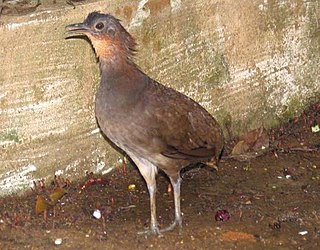
The Brazilian tinamou is a type of tinamou found in tropical moist lowland forest in regions of Amazonian South America.

The black-capped tinamou is a type of tinamou commonly found in the moist forest lowlands in subtropical and tropical regions.

The barred tinamou is a type of tinamou commonly found in lowland moist forest in subtropical and tropical regions of northern South America.

Taczanowski's tinamou is a type of ground bird found in the eastern Andes in Peru in the Junín, Cuzco, Apurímac, Ayacucho, and Puno Regions.

The curve-billed tinamou is a type of tinamou commonly found in high-altitude grassland and shrubland habitats in the Andes of South America.
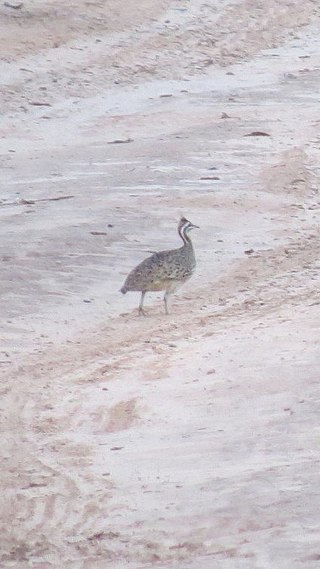
The quebracho crested tinamou is a species of tinamou found in dry forest habitats in Paraguay and northern Argentina in South America.

This is a list of the tallest extant birds according to maximum height. Birds range from a tiny bee hummingbird, which is only 5–6 cm (2.0–2.4 in), to the giant African ostrich, almost 280 cm (9.2 ft) in height.























